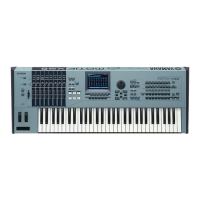Playing the Keyboard in the Voice Play Mode
MOTIF XS Owner’s Manual
91
Voice mode
Song mode
Pattern mode
Mixing mode
Master mode
Utility mode
File mode
Performance
mode
Sampling
mode 1
Sampling
mode 2
Reference
The eight Control Sliders let you adjust the volume of eight
Elements (page 56) making up the current Normal Voice.
Each of the Control Sliders 1 – 8 corresponds to each of
Elements 1 – 8. It is a good idea to check which Elements
are used for the current Normal Voice by using the
Information display (page 93) before using the Control
Sliders. Keep in mind that when a Drum Voice is selected,
a single Slider may affect the volume of all sounds/keys
simultaneously.
When changing the value of the parameter in the Voice
Play or Edit mode, the [E] (Edit) Indicator will appear on the
top right corner of the LCD display. This gives a quick
confirmation that the current Voice has been modified but
not yet stored. To store the current edited status, follow the
instructions on page 97.
Keyboard MIDI transmit channel
setting
You can set the MIDI transmit channel over which the
keyboard/controller performance sends MIDI data (to an
external sequencer, tone generator, or other device).
1 Press the [TRACK] button so that its lamp
lights.
2 Pressing any of the Number buttons [1] – [16]
to determine the MIDI transmit channel.
3 After setting, press the [PROGRAM] button to
return to the original status.
n This parameter is same as the Keyboard Transmit
Channel (page 268) in the MIDI display of the Utility
mode. Making a setting here automatically changes the
setting of that parameter as well.
Keyboard Octave setting
Sometimes when playing a Voice, you may wish to play in a
lower or higher pitch range. For example, you may want to
shift the pitch down lower to get extra bass notes, or shift up
to get higher notes for leads and solos. The Octave Up/Down
controls let you do this quickly and easily. Each time you press
the OCTAVE [UP] button on the panel, the overall pitch of the
Voice goes up by one octave. Likewise, each press of the
OCTAVE [DOWN] button takes the pitch down by one octave.
The range is from -3 to +3, with 0 being standard pitch. The
current octave setting is shown at the top right of the display.
You can instantly restore standard pitch (0) by simultaneously
pressing both the OCTAVE [UP] button and the OCTAVE
[DOWN] button (both lamps turn off).
The lamp status of the OCTAVE [DOWN]/[UP] button lets you
recognize at a glance the current octave setting. When set to
one octave down or up, the corresponding lamp lights. When
set to two octaves down or up, the corresponding lamp
flashes slowly. When set to three octaves down or up, the
corresponding lamp flashes quickly.
n This parameter is same as the Octave (page 260) in the Play
display of the Utility mode. Making a setting here automatically
changes the setting of that parameter as well.
n If you wish to shift notes on the keyboard up or down in
semitones, edit the Transpose parameter (page 260) in the
Play display of the Utility mode.
Using the Arpeggio function
The Arpeggio function lets you trigger rhythm patterns, riffs
and phrases using the current Voice by simply playing
notes on the keyboard. For instructions on using the
Arpeggio, refer to the Start Guide on page 24.
The Voice Play display
The Voice Play display is the first display called up when
pressing the [VOICE] button and entering the Voice mode.
Control Slider functions
The [E] Indicator
Edit Indicator

